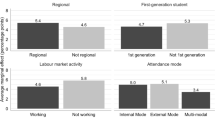Abstract
We examined the association between HIV infection and educational attainment level among a population of 34,512 voluntary counseling and testing (VCT) clients in Ethiopia, using client data from the Family Guidance Association of Ethiopia (FGAE). Overall, more than 50 percent of the VCT clients report at least secondary level educational attainment, and HIV prevalence is 8.5 percent for men and 14.3 percent for women. HIV prevalence decreases significantly with each increase in education level for both men and women, and this association persists at secondary and higher education levels in the multivariate model. Male and female VCT clients with more than secondary level education are 58 percent and 66 percent (respectively) less likely to be HIV-positive than those with no education. HIV prevention and treatment interventions in Ethiopia should target less educated segments of the population including women, who have higher HIV prevalence and lower educational attainment than men.
Similar content being viewed by others
References
Abebe, Y., Schaap, A., Mamo, G., Negussie, A., Darimo, B., Wolday, D., & Sanders, E. J. (2003). HIV prevalence in 72,000 urban and rural male army recruits, Ethiopia. AIDS, 17, 1835–1840.
Auvert, B., Buve, A., Ferry, B., Carael, M., Morison, L., Lagarde, E., Robinson, N. J., Kahindo, M., Chege, J., Rutenberg, N., Musonda, R., Laourou, M., & Akam, E. (2001). Study Group on the Heterogeneity of HIV Epidemics in African Cities. Ecological and individual level analysis of risk factors for HIV infection in four urban populations in sub-Saharan Africa with different levels of HIV infection. AIDS, 15, S15–S30.
Central Statistical Authority (Ethiopia) & ORC Macro. Ethiopia Demographic and Health Survey 2000 (2001). Addis Ababa, Ethiopia and Calverton, Maryland, USA: Central Statistical Authority & ORC Macro.
de Walque, D., Nakiyingi-Miiro, J. S., Busingye, J., & Whitworth, J. A. (2005). Changing association between schooling levels and HIV-1 infection over 11 years in a rural population cohort in south-west Uganda. Tropical Medicine & International Health, 10, 993–1001.
Federal Ministry of Health, Ethiopia (2004). AIDS in Ethiopia (5th ed.), Addis Ababa: Disease Prevention and Control Department, Ministry of Health.
Fontanet, A. L., Woldemichael, T., Sahlu, T., van Dam, G. J., Messele, T., Rinke, d. W., Masho, W., Yeneneh, H., Coutinho, R. A., & van Lieshout, L. (2000). Epidemiology of HIV and Schistosoma mansoni infections among sugar-estate residents in Ethiopia. Annals of Tropical Medicine and Parasitology, 94, 145–155.
Fylkesnes, K., Musonda, R. M., Sichone, M., Ndhlovu, Z., Tembo, F., & Monze, M. (2001). Declining HIV prevalence and risk behaviours in Zambia: evidence from surveillance and population-based surveys. AIDS, 15, 907–916.
Glynn, J. R., Carael, M., Buve, A., Anagonou, S., Zekeng, L., Kahindo, M., & Musonda, R. (2004). Does increased general schooling protect against HIV infection? A study in four African cities. Tropical Medicine & International Health, 9, 4–14.
Grosskurth, H., Mosha, F., Todd, J., Senkoro, K., Newell, J., Klokke, A., Changalucha, J., West, B., Mayaud. P., & Gavyole, A. (1995). A community trial of the impact of improved sexually transmitted disease treatment on the HIV epidemic in rural Tanzania: 2. Baseline survey results. AIDS, 9, 927–934.
Hargreaves, J. R., & Glynn, J. R. (2002). Educational attainment and HIV-1 infection in developing countries: a systematic review. Tropical Medicine & International Health, 7, 489–498.
Kilian, A. H., Gregson, S., Ndyanabangi, B., Walusaga, K., Kipp, W., Sahlmuller, G., Garnett, G. P., Asiimwe-Okiror, G., Kabagambe, G., Weis, P., & von Sonnenburg, F. (1999). Reductions in risk behaviour provide the most consistent explanation for declining HIV-1 prevalence in Uganda. AIDS, 13, 391–398.
Lagarde, E., Carael, M., Glynn, J. R., Kanhonou, L., Abega, S. C., Kahindo, M., Musonda, R.,Auvert, B., Buve, A., & Study Group on the Heterogeneity of HIV Epidemics in African Cities. (2001). Educational level is associated with condom use within non-spousal partnerships in four cities of sub-Saharan Africa. AIDS, 15, 1399–1408.
Over, M., & Piot, P. (1993). HIV infection and sexually transmitted diseases. In D. T. Jamison, W. H. Mosley, A. R. Mensham, J. L. Bobadilla (Eds.), Disease Control Priorities in Developing Countries. Oxford: Oxford University Press.
Quigley, M., Munguti, K., Grosskurth, H., Todd, J., Mosha, F., Senkoro, K., Newell, J., Mayaud, P., ka-Gina, G., Klokke, A., Mabey, D., Gavyole, A., & Hayes, R. (1997). Sexual behaviour patterns and other risk factors for HIV infection in rural Tanzania: a case-control study. AIDS, 11, 237–248.
Senkoro, K. P., Boerma, J. T., Klokke, A. H., Ng’weshemi, J. Z., Muro, A. S., Gabone, R., & Borgdorff, M. W. (2000). HIV incidence and HIV-associated mortality in a cohort of factory workers and their spouses in Tanzania, 1991 through 1996. Journal of Acquired Immune Deficiency Syndromes, 23, 194–202.
Smith, J., Nalagoda, F., Wawer, M. J., Serwadda, D., Sewankambo, N., Konde-Lule, J., Lutalo, T., Li, C., & Gray, R. H. (1999). Education attainment as a predictor of HIV risk in rural Uganda: results from a population-based study. International Journal of STD & AIDS, 10, 452–459.
Taha, T. E., Dallabetta, G. A., Hoover, D. R., Chiphangwi, J. D., Mtimavalye, L. A., Liomba, G. N.,Kumwenda, N. I., & Miotti, P. G. (1998). Trends of HIV-1 and sexually transmitted diseases among pregnant and postpartum women in urban Malawi. AIDS, 12, 197–203.
Joint United Nations Programme on HIV/AIDS (UNAIDS) (2004). Report on the Global AIDS Epidemic. Joint United Nations Programme on HIV/AIDS (UNAIDS) 2004.
Joint United Nations Programme on HIV/AIDS (UNAIDS) & the World Health Organization (WHO) (2005). AIDS epidemic update: December 2005: Special section on HIV prevention.
United Nations Population Fund (UNFPA) (2005). State of World Population 2005. The Promise of Equality: Gender Equity, Reproductive Health and the Millennium Development Goals. (UNFPA).
Acknowledgements
The authors gratefully acknowledge support for conducting this research from the Bill and Melinda Gates Institute for Population and Reproductive Health.
Author information
Authors and Affiliations
Corresponding author
Rights and permissions
About this article
Cite this article
Bradley, H., Bedada, A., Brahmbhatt, H. et al. Educational Attainment and HIV Status among Ethiopian Voluntary Counseling and Testing Clients. AIDS Behav 11, 736–742 (2007). https://doi.org/10.1007/s10461-006-9185-4
Received:
Accepted:
Published:
Issue Date:
DOI: https://doi.org/10.1007/s10461-006-9185-4




